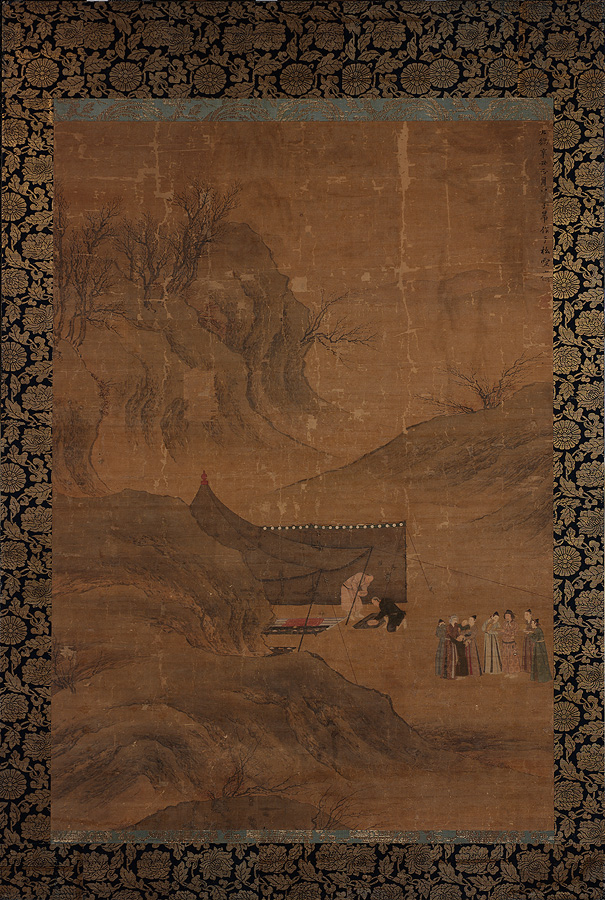| Maker(s): | Possibly Sheng Mou | | Culture: | Chinese (active early-mid 14th century)
| | Title: | Departure of Lady Wenji from the Nomad Camp
| | Date Made: | Yuan dynasty (1271-1368), 14th century
| | Type: | Painting
| | Materials: | Ink and color on silk mounted on panel
| | Place Made: | China
| | Measurements: | scroll: 58 7/8 x 43 1/2 in; 149.5425 x 110.5 cm; image: 51 in x 36 in; 129.54 cm x 91.44 cm
| | Narrative Inscription: | inscriptionTa-te, hsin-ch'ou, cheng yueh pa (jih?), Tzu-ang tso yu Sung-hsueh-chai (translatinon: in the era, year, A.D. 1301, first month, eigth day, Tzu-ang fecit, at the Snow Pine Studio)
| | Accession Number: | SC 1949.12.1
| | Credit Line: | Purchased with the Drayton Hillyer Fund
| | Museum Collection: | Smith College Museum of Art
|
|

|
Description:
now framed; originally scroll
Label Text:
Edgar C. Schenck (1909–1959), an expert on Oriental and Polynesian arts, directed the Honolulu Institute of Art for twelve years before coming to Northampton to serve as the director of the Smith College Museum of Art from 1947 to 1949. During his short tenure at Smith, Schenck made a notable acquisition: Departure of Lady Wenji from the Nomad Camp, a large Yuan-dynasty silk painting from the former Del Drago collection of New York. A popular theme in Song and Yuan art, the story relates the life of Lady Wenji of the Han dynasty. Wenji was captured by the troops of the Xiongnu, a northern nomadic people, and forced to marry one of their chieftains. After she had spent a dozen years with the nomads and given birth to two sons, she was finally ransomed by the Chinese minister Cao Cao (155–220) and reunited with her father. This painting depicts the last moment before Wenji’s departure for her homeland. Her husband waits to present her with a cup of wine to see her off, while her two young boys grab her hand to make her stay. A bleak landscape of twisted rock masses and leafless trees emphasizes the emotion of the charged moment. Because the inscription on the painting states it was painted by the famous Yuan artist Zhao Mengfu (1254–1322) in 1301, this large scroll was widely known among early Western scholars of Chinese art and was considered among the best works in the Del Drago collection. In 1949 Schenck purchased it for the Museum for $8,000, a considerable sum of money for a Chinese painting at the time though an inexpensive price for a “Zhao Mengfu” work. A decade later, Asian art scholars Max Loehr and James Cahill determined that the inscription was spurious and postulated that the work was painted by a northern artist in the fourteenth century. Although this painting is not by a famous artist, it remains among the finest Chinese paintings acquired by the Museum and is evidence of the Museum’s early ambition to acquire important works of Asian art for the collection. Schenck later directed the Albright-Knox Art Gallery in Buffalo and the Brooklyn Museum of Art and contributed to the development of the Asian collections at both institutions.
F. Zhang (from Collecting Art of Asia, Highlights of the Asian Collection of the Smith College Museum of Art. Northampton: Smith College Museum of Art, 2013)
Ludwig Bachhofer, "The Del Drago Collection of Chinese Paintings," Art News 35 (1937), 5-15.
Addendum
Dr. Richard Barnhart (John M. Schiff Professor Emeritus, History of Art, Yale University) examined the Departure of Lady Wenji from the Nomad Camp at SCMA on October 14, 2013. He reattributed the painting to Sheng Mou (active 1340-65), a younger contemporary of the scholar painter Zhao Mengfu, to whom the painting was originally attributed when it was acquired by Edgar Schenck. According to Dr. Barnhart, Sheng Mou was a masterful figure and landscape painter, a professional--"one of the best and most successful painters" of his time-- who was later eclipsed in importance and popularity by literati painters such as Zhao Mengfu. He believes the Museum’s painting may have been part of an eighteen-panel series of the songs/poems of Lady Wenji, and could have been mounted as a screen.
Subjects:
Silk Link to share this object record:
https://museums.fivecolleges.edu/detail.php?t=objects&type=ext&id_number=SC+1949.12.1 |